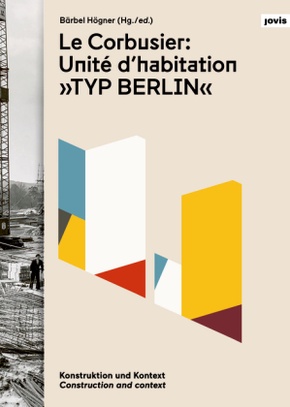Le Corbusier: Unité d'habitation "Typ Berlin" - Konstruktion und Kontext / Construction und Kontext
| Verlag | Jovis |
| Auflage | 2019 |
| Seiten | 256 |
| Format | 17,3 x 24,1 x 2,4 cm |
| Großformatiges Paperback. Klappenbroschur | |
| Gewicht | 756 g |
| ISBN-10 | 3868595635 |
| ISBN-13 | 9783868595635 |
| Bestell-Nr | 86859563A |
Le Corbusiers Unité d'habitation "Typ Berlin" - erbaut 1957 bis 1958 unweit des Olympiastadions - ist ein herausragendes Zeugnis der Berliner Nachkriegsarchitektur. Ursprünglich plante der Architekt die gigantische Wohneinheit in Anlehnung an das Marseiller Original. Strikte Vorgaben der Auftraggeber führten jedoch zu entscheidenden Veränderungen des Entwurfs, weshalb dem "Typ Berlin" eine Außenseiterposition innerhalb Le Corbusiers Oeuvre zukam.
Autoren aus den Disziplinen Architektur, Stadtplanung, Kunstgeschichte und Kulturwissenschaft zeichnen erstmals präzise die Entstehungsgeschichte des denkmalgeschützten Hauses nach. Zudem werden die Entwicklung des Modells "Unité d'habitation" und die einzigartige Farbgestaltung der Berliner Variante untersucht sowie vergleichend die vier typologisch verwandten Bauten in Frankreich vorgestellt. Mit Blick auf Bedeutung und Wirkung des ungewöhnlichen Wohnblocks, genannt "Corbusierhaus", schließt die Publikation eine Lücke in der Literatur zur Nachkriegsmoderne und zu Le Corbusiers Gesamtwerk.
Le Corbusier's Unité d'habitation "Typ Berlin"-built 1957-58-is an exceptional testimony to Berlin's post-war architecture. Although it follows the basic concept of a "vertical village" as envisioned by the architect, the gigantic block, containing 530 apartments, clearly differs from the Marseille original. However, as a result of modifications required by the client, the construction occupies the position of an outsider in Le Corbusier's oeuvre.
Authors from the fields of architecture, urbanism, art history, and cultural studies precisely set out the genesis of the listed building for the first time. In addition, they investigate the development of the "Unité d'habitation" model, the Berlin variant's unique color concept, and carry out a comparison with the four typologically related buildings in France. In looking at the significance, ingenuity, and creative impact of Le Corbusier's unique creation in Berlin, the so-called "Corbusierhaus," the publication fills a gap in the literature on post-war modernism and the architect's body of work.

